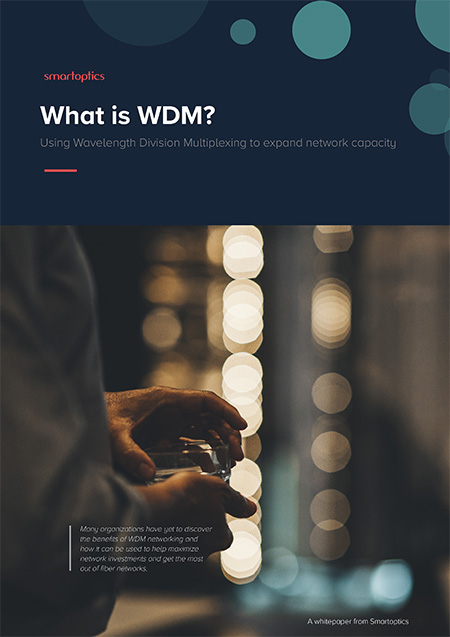THE ROLE OF FIBER OPTICS TECHNOLOGY
As the world has grown more connected and data consumption has increased exponentially, methods of transmitting data have become all the more important. From a technological standpoint, fiber optics has served as a key enabler of these trends, setting a new standard for data transmission speeds, distances and bandwidth. Fiber optic networks are now well established across the world. However, there’s no one right way to design your network, as there are different types of fiber optics solutions for different use cases.
What is fiber optics?
Fiber optics is a technology for transmitting data traffic as pulses of light over tiny optical fibers. These fibers are about the same diameter as a strand of human hair and are most commonly made of pure silica. Light travels down the core of the fiber and is prevented from escaping by cladding. Coating is used to insulate fiber optic cables from rain and other types of damage. Optical transceivers are a means of transporting data traffic in a fiber optic network by turning data into light. As wavelength-specific lasers, they convert electrical data signals from switches into optical signals that can be transmitted over fiber optic cables.
Fiber optics is capable of transmitting more data at faster speeds over longer distances than other technologies. As a result, it has become the foundation of modern data transmission and is increasingly used in telecom, internet service provider and enterprise data center networks.
Fiber optics vs copper
In the past, data was predominantly transmitted in the form of electrical signals using copper wires. By transmitting data as light instead, fiber optic cables offer substantial improvements in efficiency over copper in the form of higher bandwidth and lower signal attenuation in the same form factor.
While copper wires can be cheaper to install, fiber optic cables do not need to be maintained or replaced as oftenr. However, fiber optic cables are more fragile in a certain sense, as the signal can be lost if the cable is bent more than a few centimeters. Unlike copper wires, fiber optic cables are insensitive to electrical and magnetic interference and can be used in harsher environments such as underwater. Fiber optic cables are also significantly more lightweight, consume less power and are more secure because they are harder to tap.
The role of WDM in fiber optic networks
Wavelength Division Multiplexing (WDM) is the technology used in transceivers for transporting different data streams simultaneously over a single fiber optic cable. This means that a single optical fiber can be used for multiple data services instead of having to use one fiber per service. As a result, the ROI from each fiber optic cable is maximized by enabling increases in bandwidth and distance.
In a WDM-based fiber optic network, transceivers play a key role by converting each data stream into a unique wavelength. This is what makes it possible for WDM solutions to improve the bandwidth and efficiency of each fiber by transporting multiple data services in parallel on a single fiber or fiber pair.
Transponders are another way of deploying WDM systems in fiber optic networks by sending and receiving optical signals over a fiber optic cable. They do this by converting short-range signals from a switch into long-range WDM signals. Transceivers are smaller, simpler and consume less power while transponders are more effective for longer distances and more customizable for meeting complex fiber optic networking requirements.
Multiplexers also play a key role in optimizing WDM-based fiber optic networks. This is done by consolidating the data streams and allowing for several stream to be transmitted over a single fiber. Reconfigurable Optical Add-Drop Multiplexers (ROADMS) are an efficient, convenient and popular type of multiplexer for customizing WDM signals in fiber optic networks. A ROADM does this with the capability to add, drop, pass and redirect wavelengths carrying data channels.
Coarse and Dense Wavelength Division Multiplexing (CWDM and DWDM) are the two main types of WDM. DWDM has become increasingly popular because it multiplexes data into even more wavelengths and can support much further distances with amplification. Both CWDM and DWDM use narrow band wavelengths and support the simultaneous transmission of any mix of SAN, WAN, voice and video data services in a fiber optic network.
Multimode vs single-mode fiber optic cables
The two main types of fiber optic cables are multimode (MM) and single-mode (SM). The difference between multimode and single-mode fibers is that multi-mode has a much larger core, which has significant ramifications for the distances at which they can be used effectively. The larger cores of multimode fiber optic cables enable multiple modes of light to pass through them, increasing the number of reflections.
In practice, this means that lower-cost transceivers can be used. However, multimode fiber optic cables are only viable for very short distances. This is because of the rapid signal degradation caused by the dispersion and attenuation of the large core and because amplification cannot be used. As a result, there is little point in using multimode for distances longer than only about 200-300 meters, making it only relevant for short distances within data centers. On the other hand, the smaller cores of single-mode fiber optic cables make them a good fit for long-range networking. As a result, single-mode fiber optics is the standard for telecom operator networks and data center interconnect solutions.
Step-index multimode fiber is a cheaper and lower bandwidth option while gradient-index multimode fiber performs better, making it the most common multimode fiber optic cable in use. For single-mode fiber optic cables, non-dispersion-shifted fiber was initially used. However, it is only optimized for the 1310nm fiber region, which was the standard prior to the establishment of WDM. Dispersion-shifted fiber improved in this area with optimization for the 1550nm fiber region, but this type of fiber optic cable only supports single-wavelength operation. Non-zero dispersion-shifted fiber was the next step in development to overcome this shortcoming, making it the current no. 1 choice for new deployments given its higher bandwidth and longer distances over DWDM.
Technologies for getting the most out of your fiber optic network
From DWDM transceivers and transponders to ROADMs and open line systems, there are many networking technologies to consider for getting the most out of each of your fiber optic cables. These and other networking resources will help you extend the reach, optimize, simplify, secure and improve the performance of your fiber optic network.
Smartoptics provides innovative optical networking solutions and devices for the new era of open networking. Our solutions are based on open networking standards and are used in metro and regional network applications that increasingly rely on data center services and specifications. The products we deliver are based on in-house developed hardware and software and enhanced through associated services. Discover Smartoptics’ complete fiber optic networking product range.


Related articles

What is a SAN ( Storage Area Network) and how does it protect mission-critical workloads?

What is Fibre Channel used for?
